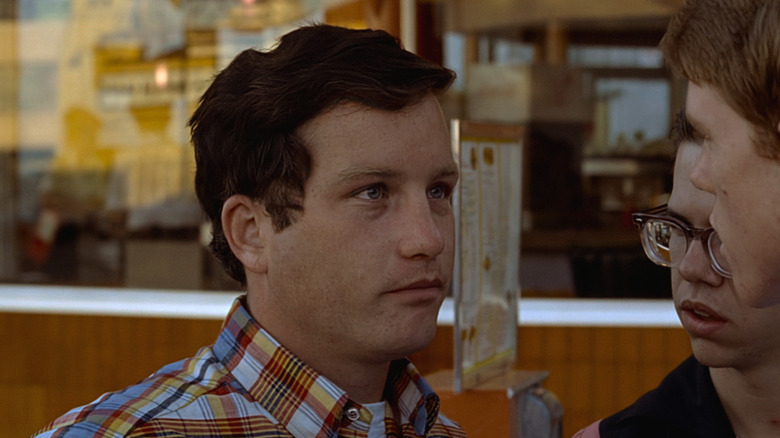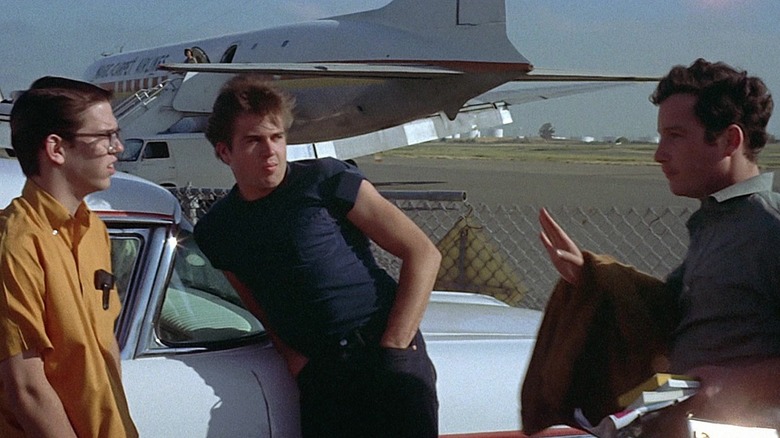This Classic Richard Dreyfuss Movie With 95% On Rotten Tomatoes Inspired Happy Days
When Garry Marshall's "Happy Days" premiered January 15, 1974, television viewers all over the country weren't exactly struck with deja vu. They were mostly confused as to why this sitcom set in the late 1950s, which follows the misadventures of a pack of male high school friends as they hang out at a local burger joint, clumsily pursue girls, and face an uncertain future as the Eisenhower era draws to a close, wasn't called "American Graffiti." After all, George Lucas' Boomer-nostalgia blockbuster (the cast of which includes a pre-"Star Wars" Harrison Ford) was still playing in movie theaters when "Happy Days" debuted. The fact that they're both about high school friends engaging in hijinks as they face an uncertain future was intentional.
The presence of Ron Howard, who co-starred as the unsettled Steve Bolander in "American Graffiti" before becoming the well-adjusted Richie Cunningham in "Happy Days," only further wedded the two productions. In an interview with the Archive of American Television, Howard explicitly cited "American Graffiti" as an influence on "Happy Days," though he also named Robert Mulligan's wistful "Summer of '42" as being integral to the sitcom's vibe. What's interesting is that Howard's Steve is by far the least interesting character in "American Graffiti," and Howard himself would go on to be overshadowed in "Happy Days." Mind you, the showbiz veteran — who went on to direct numerous classics like "Splash," "The Paper," and "Apollo 13" — isn't bitter about any of this.
Rather, "American Graffiti" (a generational sensation that currently holds a 95% critics' score on Rotten Tomatoes) introduced moviegoers to a brilliant actor who would go on to become an unconventional leading man over the next several decades. Indeed, Richard Dreyfuss probably wouldn't even sniff stardom today, but he was a marquee-topper in his prime.
American Graffiti is a melancholy Happy Days
Parallels aside, the differences between "American Graffiti" and "Happy Day" are quite significant. Marshall's show takes place in the blue-collar Midwest city of Milwaukee, whereas Lucas' movie focuses on the cruising culture of his hometown Modesto, California. "Happy Days" also became a show about the Cunningham family (into which Henry Winkler's Arthur "Fonzie" Fonzarelli was absorbed), while authority figures are largely absent in "American Graffiti." Similarly, no one in Lucas' film can start up a jukebox by giving it a firm slap, and the specter of the Vietnam War haunts and hunts the characters of "American Graffiti."
Dreyfuss' Curt Henderson, meanwhile, is the heart of "American Graffiti." He's an aspiring writer, a dreamer, and a hopeless romantic (one who spends most of the movie desperately trying to hook up with a mysterious blonde woman). He's due to depart for college the next day, leaving behind his three friends, all of whom have meager or, at best, conventional prospects. We learn in the epilogue what becomes of this quartet, and it's crushing. This is a place "Happy Days" could never go. Fonzie jumped sharks. He didn't get shipped off to die in Vietnam or get killed by a drunk driver. "Happy Days" was a lie, but it was a kind-hearted fabrication.

